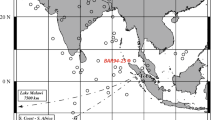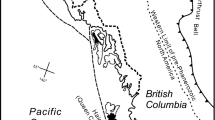Abstract
THE volcanic islands of the Galapagos archipelago are the most recent products of a long-lived mantle hotspot1,2. Little is known, however, of the submarine Galapagos platform on which the islands are built, or of the Cocos and Carnegie submarine ridges produced by past motion of the Cocos and Nazca plates across the hotspot3,4. In 1990 we surveyed selected areas around the Galapagos platform and as far east as 85°30' W on the Carnegie ridge, where we dredged abundant well-rounded basalt cobbles from a small sea-mount with a terraced summit region. Cobbles were also dredged from several other seamounts. We interpret these features, especially the presence of cobbles, as evidence for erosion near sea level and conclude that these seamounts were volcanic islands before subsiding to their present depths. Radiometric ages for these drowned islands range from 5 to 9Myr, consistent with predicted plate motions. They indicate that the time available for speciation of Galapagos organisms is much longer than the age range of the existing islands.
This is a preview of subscription content, access via your institution
Access options
Subscribe to this journal
Receive 51 print issues and online access
$199.00 per year
only $3.90 per issue
Buy this article
- Purchase on Springer Link
- Instant access to full article PDF
Prices may be subject to local taxes which are calculated during checkout
Similar content being viewed by others
References
Morgan, W. J. Nature 230, 42–43 (1971).
Morgan, W. J. Am. Assoc. Petrol. Geol. Bull. 56, 203–213 (1972).
Hey, R. N. Geol. Soc. Am. Bull. 88, 1404–1420 (1977).
Cox, A. in Patterns of Evolution in Galapagos Organisms (eds Bowman, R. I. & Leviton, A. E.) 11–23 (American Association for the Advancement of Science, Washington DC, 1983).
Malfait, B. T. thesis, Oregon State Univ. (1975).
Geist, D. J., McBimey, A. R. & Duncan, R. A. Geol. Soc. Am. Bull. 97, 555–566 (1986).
Baitis, H. W. & Swanson, F. J. Nature 259, 195–197 (1976).
Dalrymple, G. B., Lanphere, M. A. & Clague, D. A. in Init. Rep. Deep-Sea Drilling Project 55 (eds Jackson. E. D. et al.) 659–676 (US Government Printing Office, Washington, 1981).
O'Connor, J. M. & Duncan, R. A. J. geophys. Res. 95, 17475–17502 (1990).
Duncan, R. A. & Clague, D. A. in The Ocean Basins and Margins 7 A (eds Nairn, A. E. M., Stehli, F. G. & Uyeda. S.) 89–121 (Plenum. New York. 1985).
Minster, J. B. & Jordan, T. H. J. geophys. Res. 83, 5331–5354 (1978).
Gripp, A. E. & Gordon, R. G. Geophys. Res. Lett. 17, 1109–1112 (1990).
Duncan, R. A. & Hargraves, R. B. in The Caribbean-South American Plate Boundary and Regional Tectonics, Geol. Soc. Am. Mem. 162 (eds Bonini, W. E., Hargraves, R. B. & Shagam, R.) 81–94 (1985).
Hickman, C. S. & Lipps, J. H. Science 227, 1578–1580 (1985).
Wiles, J. S. & Sarich, V. M. in Patterns of Evolution in Galapagos Organisms (eds Bowman, R. I. & Leviton, A. E.) 177–186 (American Association for the Advancement of Science, Washington DC, 1983).
Sen, G., Hickey-Vargas, R., Waggoner, D. G. & Maurasse, F. Earth planet. Sci. Lett 87, 423–437 (1988).
Author information
Authors and Affiliations
Rights and permissions
About this article
Cite this article
Christie, D., Duncan, R., McBirney, A. et al. Drowned islands downstream from the Galapagos hotspot imply extended speciation times. Nature 355, 246–248 (1992). https://doi.org/10.1038/355246a0
Received:
Accepted:
Issue Date:
DOI: https://doi.org/10.1038/355246a0
Comments
By submitting a comment you agree to abide by our Terms and Community Guidelines. If you find something abusive or that does not comply with our terms or guidelines please flag it as inappropriate.



